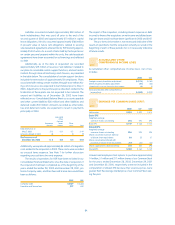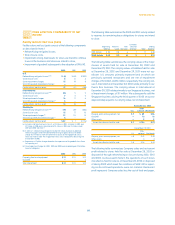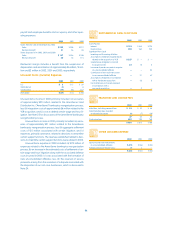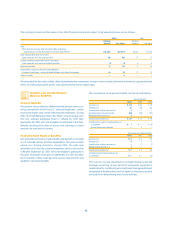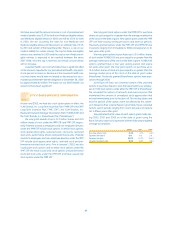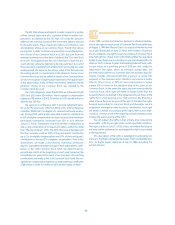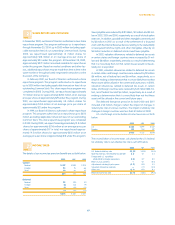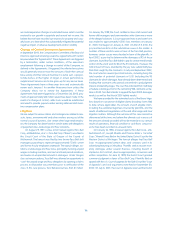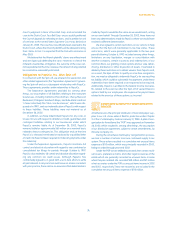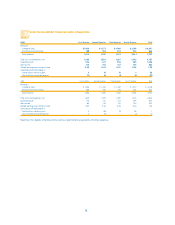Pizza Hut 2002 Annual Report Download - page 66
Download and view the complete annual report
Please find page 66 of the 2002 Pizza Hut annual report below. You can navigate through the pages in the report by either clicking on the pages listed below, or by using the keyword search tool below to find specific information within the annual report.
We have assumed the annual increase in cost of postretirement
medical benefits was 12.0% for both non-Medicare eligible retirees
and Medicare eligible retirees in 2002 and will be 12.0% for both
in 2003. We are assuming the rates for non-Medicare and
Medicare eligible retirees will decrease to an ultimate rate of 5.5%
by 2011 and remain at that level thereafter. There is a cap on our
medical liability for certain retirees. The cap for Medicare eligible
retirees was reached in 2000 and the cap for non-Medicare eli-
gible retirees is expected to be reached between the years
2007-2008; once the cap is reached, our annual cost per retiree
will not increase.
Assumed health care cost trend rates have a significant effect
on the amounts reported for our postretirement health care plans.
A one percent increase or decrease in the assumed health care
cost trend rates would have increased or decreased our accu-
mulated postretirement benefit obligation at December 28, 2002
by approximately $2 million. The impact on our 2002 benefit cost
would not have been significant.
STOCK-BASED EMPLOYEE COMPENSATION
At year-end 2002, we had four stock option plans in effect: the
YUM! Brands, Inc. Long-Term Incentive Plan (“1999 LTIP”), the 1997
Long-Term Incentive Plan (“1997 LTIP”), the YUM! Brands, Inc.
Restaurant General Manager Stock Option Plan (“YUMBUCKS”) and
the YUM! Brands, Inc. SharePower Plan (“SharePower”).
We may grant awards of up to 15.2 million shares and 45.0
million shares of stock under the 1999 LTIP and 1997 LTIP, respec-
tively. Potential awards to employees and non-employee directors
under the 1999 LTIP include stock options, incentive stock options,
stock appreciation rights, restricted stock, stock units, restricted
stock units, performance shares and performance units. Potential
awards to employees and non-employee directors under the 1997
LTIP include stock appreciation rights, restricted stock and per-
formance restricted stock units. Prior to January 1, 2002, we also
could grant stock options and incentive stock options under the
1997 LTIP. We have issued only stock options and performance
restricted stock units under the 1997 LTIP and have issued only
stock options under the 1999 LTIP.
NOTE
18
We may grant stock options under the 1999 LTIP to purchase
shares at a price equal to or greater than the average market price
of the stock on the date of grant. New option grants under the 1999
LTIP can have varying vesting provisions and exercise periods.
Previously granted options under the 1997 LTIP and 1999 LTIP vest
in periods ranging from immediate to 2006 and expire ten to fif-
teen years after grant.
We may grant options to purchase up to 15.0 million shares
of stock under YUMBUCKS at a price equal to or greater than the
average market price of the stock on the date of grant. YUMBUCKS
options granted have a four year vesting period and expire
ten years after grant. We may grant options to purchase up to
14.0 million shares of stock at a price equal to or greater than the
average market price of the stock on the date of grant under
SharePower. Previously granted SharePower options have expi-
rations through 2006.
At the Spin-off Date, we converted certain of the unvested
options to purchase PepsiCo stock that were held by our employ-
ees to YUM stock options under either the 1997 LTIP or SharePower.
We converted the options at amounts and exercise prices that
maintained the amount of unrealized stock appreciation that
existed immediately prior to the Spin-off. The vesting dates and
exercise periods of the options were not affected by the conver-
sion. Based on their original PepsiCo grant date, these converted
options vest in periods ranging from one to ten years and expire
ten to fifteen years after grant.
We estimated the fair value of each option grant made dur-
ing 2002, 2001 and 2000 as of the date of grant using the
Black-Scholes option-pricing model with the following weighted
average assumptions:
2002 2001 2000
Risk-free interest rate 4.3% 4.7% 6.4%
Expected life (years) 6.0 6.0 6.0
Expected volatility 33.9% 32.7% 32.6%
Expected dividend yield 0.0% 0.0% 0.0%
64.


